Mexico’s Yucatán peninsula is one of my favourite states in Mexico. This region is so jam-packed with cultural sights, beautiful beaches and wildlife encounters that you could spend months, if not years, exploring it all.
Unfortunately, however, I didn’t have quite so long. But during the various trips that I made to the Yucatan, I did manage to cram in plenty of highlights from mayan ruins and some of the best cenotes in the Yucatan to beautiful beaches and islands.
If, like me, you don’t have time to see everything then this travel guide to the best things to do in the Yucatan will help you narrow down what to see first.
Disclosure: updated 2020. Some locations may be closed owing to Covid-19, please check with the destination before travelling. This post may contain affiliate links, please see our disclosure policy for more information.
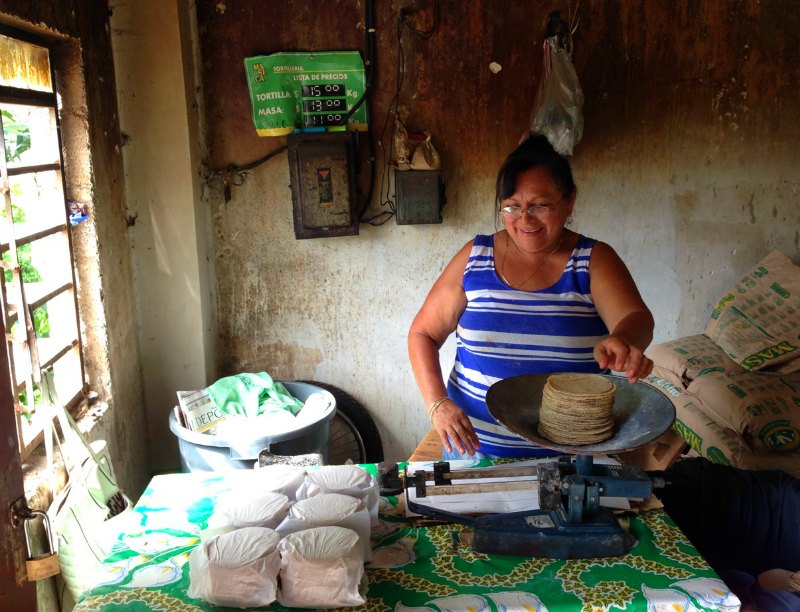
[author] [author_info]Don’t miss our guide to visiting Tulum with kids or our review of the luxury Hacienda Petac near Merida. If you’re visiting Mexico City then you must read our tips on the 50 best things to do with kids. And don’t miss the 7 best wineries in Valle de Guadalupe.[/author_info] [/author]
Yucatán Highlights
Table of Contents
It’s well worth considering a tour of Mexico’s Yucatan province, particularly if you are short on time. During one of my trips I spent a day with Lawson’s Original Yucatan Excursions. Run by Ralph, a Canadian living in Merida, this small outfit organises custom-made Yucatan tours including many great options for families.
If you have longer then consider one of the Yucatan’s many islands for a holiday. Isla Mujeres is located 13km off the coast of Cancun. It’s well-known for its laidback vibe, its snorkelling and scuba diving opportunities and its pristine beaches and seas.
Car-free Isla Holbox is part of the Yum Balam, Mexico’s largest ecological reserve and nearly 75 percent of the island is covered in wild mangroves and pristine beaches. Come here for the peace and tranquility, and the wildlife. The waters surrounding the island are home to whale sharks from June to September and you can take a sea safari to see them feed.
Further south is Bacalar Lagoon, the second largest freshwater lagoon in Mexico that dazzles visitors with its fresh turquoise waters.
Discover Merida
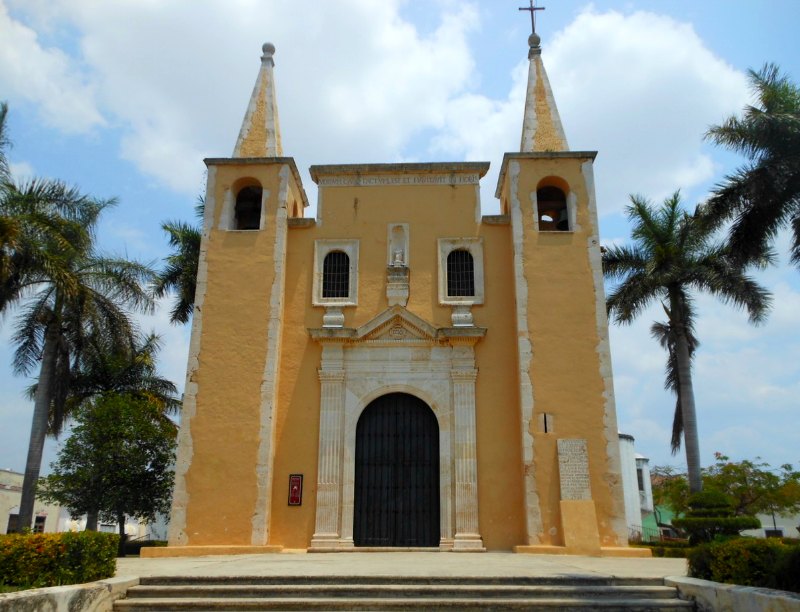
Merida is the capital and the largest city in the Mexican state of Yucatán.
Once upon a time, this was the richest city in the world. The source of all this wealth was henequen (also known as sisal), fibre extracted from the agave plant used to make a wide range of products including ropes and hammocks.
The Yucatán region is uniquely suited to growing agave plants and during the ‘Green Gold’ heyday, countless haciendas sprung up on the outskirts of town to cultivate the crop. Within the city centre wealthy elite built impressive colonial mansions.
Although Merida’s golden age has long since gone, there remains an abundance of buildings from this period along the grand Paseo de Montejo Boulevard, a wide, tree-lined street fashioned after the Champs-Élysée in Paris.
Two of the most impressive buildings are the Twin Houses, identical French houses that sit side by side with ornate wrought iron gates and balconies.
Their neighbour is the pink Palacio Canton, once the grandest mansion in town and today the Museo Regional de Antropologia (Regional Anthropology Museum).

Mayan ruins in the Yucatán

You’re spoiled for choice when it comes to Mayan ruins in the Yucatan. From the big ticket ruins such as Chichen Itza to lesser known sites including Coba, there’s a ruin for every kind of budding archeologist. The following are the ones I think are well worth a visit.
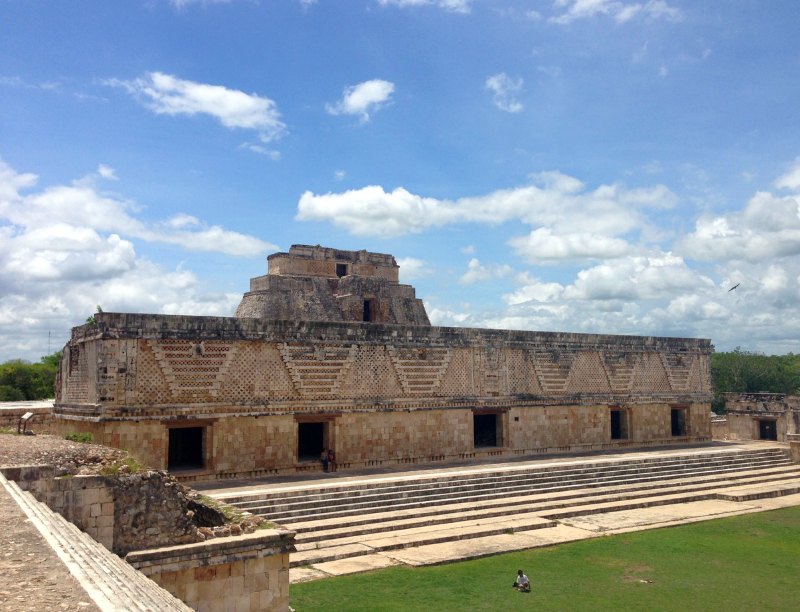
Uxmal
The Maya site of Uxmal (pronounced oosh-mal) is one of the most important archaeological sites in Mexico and is a UNESCO World Heritage Site.
I was bowled over by the sheer size of the ancient city as well as the detail and ornamentation. Uxmal means “thrice built” and it is understood that the city was built over three different periods. The buildings date from between 700 and 1,000 A.D. and showcase different architectural styles.
Unlike other Mayan sites, Uxmal is not laid out geometrically and is instead organised in relation to astronomical phenomena.
Interestingly, this was one of the few sites that the Mayans built where there was no obvious water source. It’s thought that they chose this spot for the agricultural soil and then built cisterns and reservoirs for catching and storing water. In it’s heyday, some 25,000 people lived here.
At the heart of the site is the Temple of the Magician, which, according to legend, was built by a dwarf king. If you clap your hands loudly in front of the temple it produces a chirped echo similar to the cry of the quetzal bird. Given its name, it’s tempting to believe that this phenomenon is indeed magic. Our guide explained, however, that the sound is produced because of metal elements in the limestone rock.
Other important buildings include the Quadrangle of the Nuns, the Governor’s Palace, the House of the Tortoises and the Ball Court. And there are still areas of the site that have not been fully discovered.
Getting there: Uxmal is located 62km south of Mérida on highway 261.
Tulum Ruins
Location, location, location; the Mayans certainly knew where to build their sites and the address for Tulum is no exception.
The pre-Colombian Mayan site of Tulum is simply magical, overlooking the the Caribbean Sea. This was the only Mayan city built on a coastline and was once used as a seaport, trading in mainly turquoise and jade.
It was also one of the few Mayan cities to be protected by a wall that enclosed the site on three sides.
The Mayan structures are today home to dozens and dozens of iguanas that bask in the Mexican sun all day long. Visit the Tulum Ruins in the morning, before the crowds and before it gets too hot.
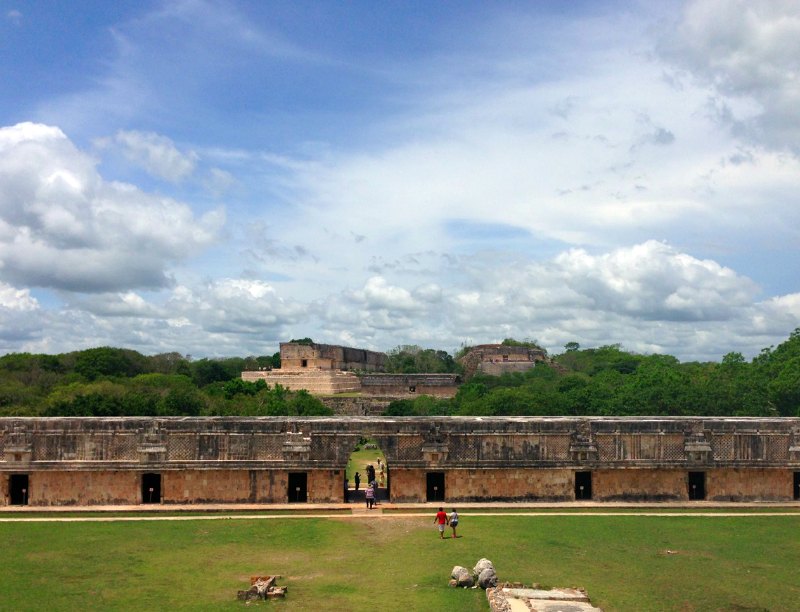
Coba Ruins
If ever you wanted to be on the set of an Indiana Jones move then the Coba Archaeological Site is it. Located roughly 50km away from Tulum, this fascinating site feels largely undiscovered. As long as you ignore the tour buses of course!
That said, much like Tikal in Guatemala, there are still vast swathes of this archaeological site that have not been excavated. It’s set among the jungle, between two lagoons, so at times it does feel like you are walking in uncharted territory.
What has been discovered are three settlements, two ball courts and Nohoch Mul, the highest Mayan pyramid in the Yucatan.
Explore the site by foot, by bicycle or by cycle rickshaw. Climb the 120 steps to the top of Nohoch Mul and be rewarded with amazing views but we ready to slide back down the steep stairs on your bottom!
Cenotes in the Yucatan
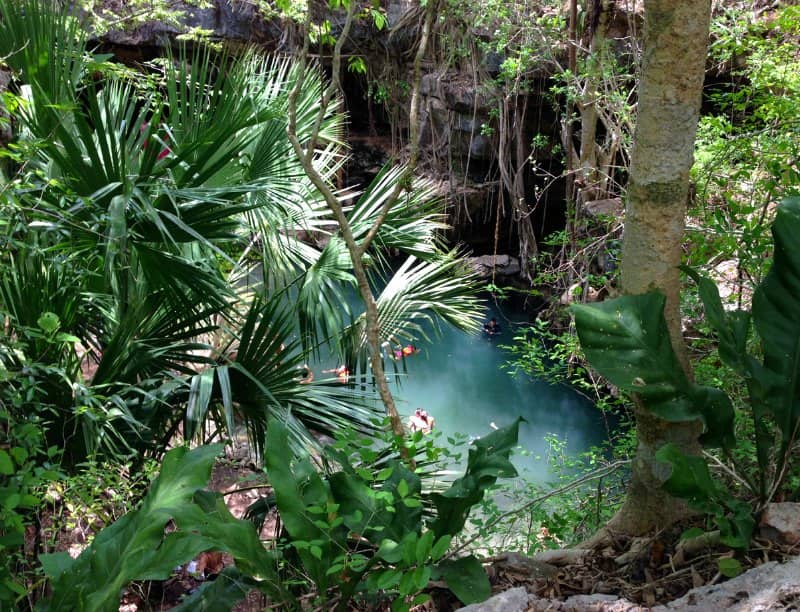
Cenotes, meaning ‘natural well’ in Mayan, are sinkholes formed by the collapse of porous limestone rock. These natural pools can be found in a handful of places around the world but the Yucatan claims most of them – and many are still undiscovered.
The ancient Maya believed that the rain god Chaak, lived in these caves and natural wells. The water in these pools is usually beautifully clear, having been filtered by the earth. Today they are a wonderful place to swim.
There are four different types of cenotes: Open, Semi-Open, Cave and Ancient.
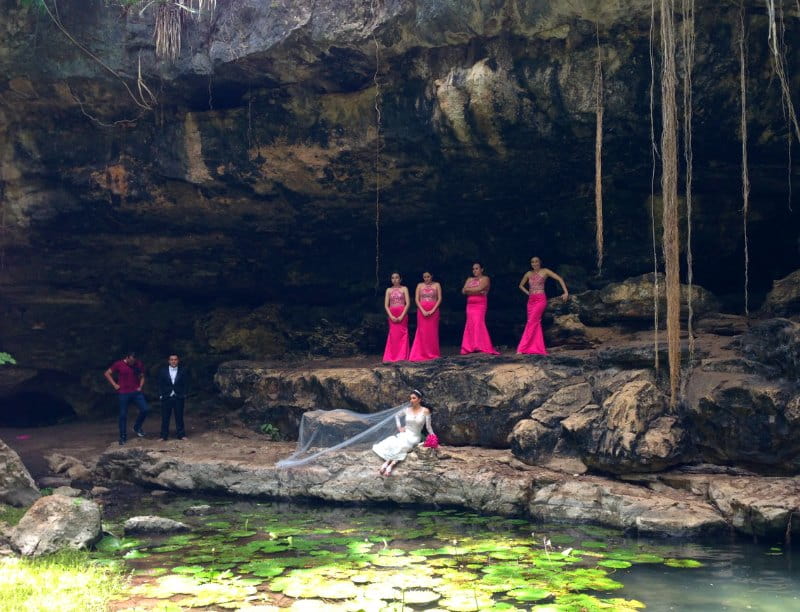
X’batún Cenote
We visited the X’batún Cenote, a small open cenote with a cave system popular for scuba diving. Unfortunately, because we visited at the weekend, the cenote was fairly crowded. This meant that the water was not the translucent turquoise that we expected but rather a murky blue.
Nevertheless, we jumped in and were delighted to find that a bridal party was in the process of having their photos taken. In the cenote!
This is not the best cenote for kids, the slippery rocks make getting in and out of the water a little difficult (bring water shoes!).
Cenote Dos Ojos (Two Eyes)
Located on Highway 307, south of Playa del Carmen and north of Tulum. It’s one of the most famous centoes in Tulum owing to its electric blue waters and stalagtyte formations.
Gran Cenote
Big Cenote is one of the most popular centoes located near Tulum. We visited with the kids and everyone loved it. It’s a great one for families as there are parts of the cenote that are shallow enough to wade in.
Another family-friendly cenote is Ik Kil, located approximately three miles from Chichen Itza.
Cenote Calavera
This is a great option if you’re in Tulum with teens. The cenote is accessed by a hole in the top of the rock. It’s also a popular dive site with many chambers for cave diving.
Car Wash Cenote
For a cenote experience away from the crowds try this large cenote. The crystal clear waters are perfect for snorkelling or diving. Car Wash Cenote is 8km away from Tulum. Next door is Cenote Zacil sits next door and is much more developed with changing rooms, a restaurant and even a zipline.
Cenote Azul
South of Playa del Carmen in the Riviera Maya, Cenote Azul is another good option for kids. It’s an open cenote with shallow parts for paddling and deeper areas where you can swim.
Other things to see in the Yucatan
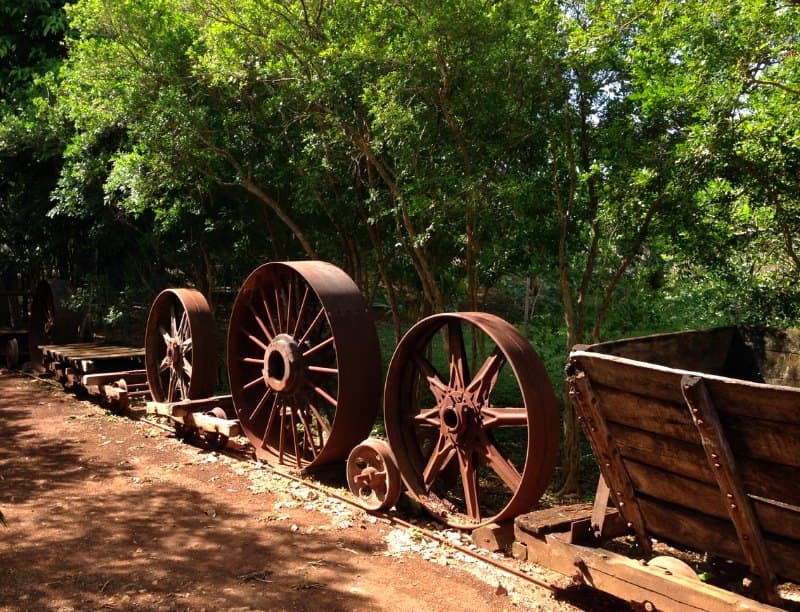
Hacienda Yaxcopoil
Hacienda Yaxcopoil (pronounced yash-coh-poh-eel) was once one of the most important rural estates in the Yucatán. In its heyday, this hacienda covered 22,000 acres, operating first as a cattle ranch and later as a henequen plantation.
Most haciendas in the region were abandoned in 1936, however production at Yaxopoil continued until 1988 and only stopped because Hurricane Gilbert wiped out the entire henequen crop.
I loved the sheer size and grandeur of the hacienda. Although the hacienda hasn’t been restored it has been well preserved and you can just imagine what it must have looked like in its heyday. That said, working conditions at the hacienda were tough. Yaxcopoil employed some 800 – 1,000 workers who started work daily at 5am and who were expected to pick 2,000 leaves a day.
Tours of the casa principal, the main house, and the well-preserved machine house (casa de maquina) are available although we sadly didn’t have time. The machine house is where the henequen shredding machines removed fibres from the henequen plant. There is also a guest house on the property for overnight stays. Today Yaxopoil is used as a backdrop for films and photos shoots as well as a location for events.
Yaxcopoil means ‘place of the big green trees’ in the Yucatec Maya language and you can see one of these trees still standing in front of the hacienda today.
Haciendas in the Yucatan
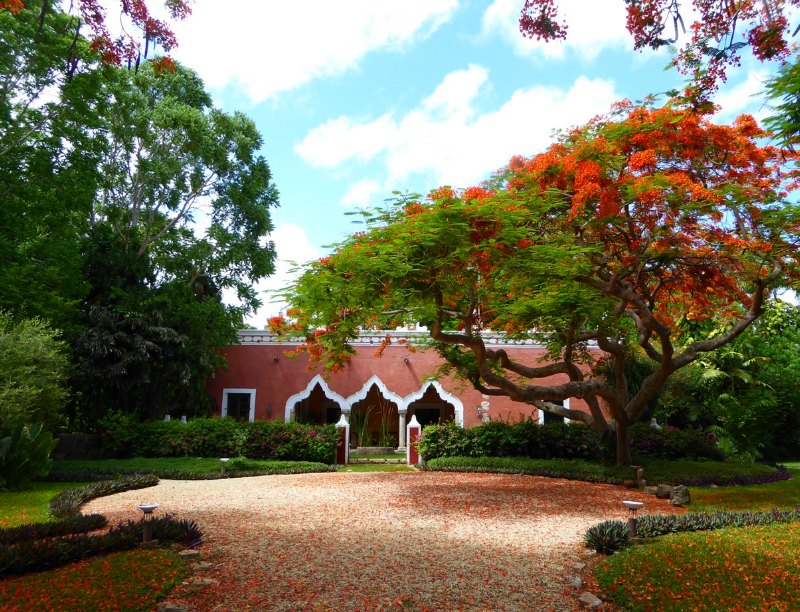
There are myriad haciendas in this region that have been carefully restored to create boutique hotels or luxury holiday homes. We stayed at Hacienda Petac, one of the oldest houses in the area. It was bought 20 years ago by an American couple who then spent nearly four-years transforming it into a beautiful home available to rent exclusively. It’s the perfect destination for families or friends wanting to holiday together. You can read all about Hacienda Petac here.
